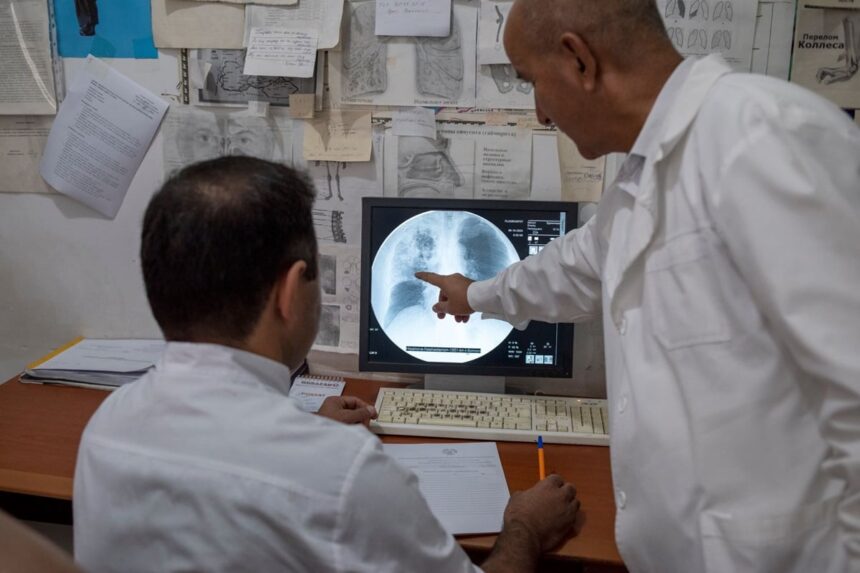“`html
The World Health Organization (WHO) has released a significant report on tuberculosis (TB), indicating that around 8.2 million individuals were newly diagnosed with the disease in 2023. This figure marks the highest incidence since WHO began tracking TB globally in 1995, reflecting an increase from the 7.5 million cases reported in 2022. Consequently, TB has reclaimed its position as the leading infectious disease killer for the year, surpassing COVID-19.
According to WHO’s Global Tuberculosis Report 2024, progress in combating TB remains inconsistent due to ongoing challenges such as severe underfunding. Although there was a decline in TB-related fatalities from 1.32 million in 2022 to approximately 1.25 million in 2023, the total number of individuals falling ill with TB increased slightly to an estimated total of about 10.8 million.
The burden of this disease is disproportionately felt by populations within thirty high-burden countries, with India (26%), Indonesia (10%), China (6.8%), the Philippines (6.8%), and Pakistan (6.3%) collectively accounting for over half of global TB cases. The report also reveals demographic insights: men constituted about 55% of those diagnosed with TB, while women made up roughly one-third and children and young adolescents represented around twelve percent.
“It is unacceptable that tuberculosis continues to claim so many lives when we possess effective tools for prevention, detection, and treatment,” stated Dr Tedros Adhanom Ghebreyesus, Director-General of WHO. “We call upon all nations to fulfill their commitments towards expanding access to these essential resources and ultimately eradicating tuberculosis.”
In terms of reporting accuracy, there was a reduction in the gap between estimated new cases and those officially recorded; it narrowed down to approximately 2.7 million compared to pandemic levels exceeding four million during both years of COVID-19 disruptions—2020 and 2021—thanks largely to extensive recovery efforts aimed at restoring disrupted services related to tuberculosis care.
Despite some improvements, multidrug-resistant tuberculosis remains a critical public health issue; treatment success rates for multidrug-resistant or rifampicin-resistant strains have reached only about sixty-eight percent this year while only forty-four percent out of an estimated four hundred thousand individuals who developed these resistant forms received proper diagnosis and treatment.
Challenges Related To Funding
Funding dedicated towards preventing and treating tuberculosis saw further declines globally throughout this past year; it remains significantly below necessary targets set forth by health organizations worldwide. Low- and middle-income countries—which account for ninety-eight percent of global TB cases—are experiencing acute funding shortages: only $5.7 billion out of an annual target requirement totaling $22 billion was available this year—a mere twenty-six percent coverage rate against what is needed.
The international donor contributions directed toward low- and middle-income nations have stagnated at around $1 billion annually over recent years despite ongoing needs within these regions remaining critical; notably among donors—the United States government stands as the largest bilateral contributor toward tackling tuberculosis issues globally while support from entities like The Global Fund plays a vital role but still falls short regarding comprehensive service provision requirements across affected areas.
Research into new diagnostics or treatments for tuberculosis suffers from severe underfunding too—with just one-fifth achieved against its annual target goal set at $5 billion last year hindering advancements necessary for developing innovative solutions such as vaccines or novel therapeutic agents aimed specifically at combating this persistent epidemic effectively moving forward into future decades ahead!
The Multifaceted Nature Of The Epidemic
This year’s report introduces estimates concerning households impacted by catastrophic costs associated with accessing diagnosis/treatment services related directly back towards their respective incomes—indicating that fifty percent face overwhelming financial burdens exceeding twenty percent annually!
A considerable portion arises due primarily through five key risk factors: malnutrition levels among populations affected overall alongside HIV infections prevalent throughout communities coupled together alongside alcohol use disorders/smoking habits particularly common amongst males plus diabetes prevalence rates rising steadily necessitating coordinated multisectoral responses addressing poverty/GDP per capita disparities simultaneously!
“We are facing numerous daunting challenges including funding deficits along with catastrophic financial impacts on families affected compounded further still through climate change conflicts/migration patterns emerging post-pandemic periods alongside drug resistance issues exacerbating antimicrobial resistance concerns,” remarked Dr Tereza Kasaeva—the Director overseeing WHO’s Global Tuberculosis Programme initiatives currently underway! “It’s crucial we unite across sectors/stakeholders alike confronting pressing matters head-on ramping up our collective efforts!”
Current global milestones targeting reductions within overall burdens posed by diseases like Tuberculosis remain off-track requiring substantial progress if we hope achieve other objectives outlined ahead before upcoming UN High-Level Meeting scheduled later next year! Therefore WHO urges governments/partners/donors alike urgently translate commitments made during recent meetings into actionable steps taken immediately increasing investments directed specifically toward research initiatives focused primarily upon developing new vaccines accelerating progress achieving established goals set forth prior deadlines approaching rapidly!
Source
“`






